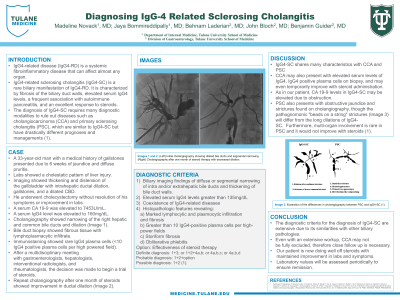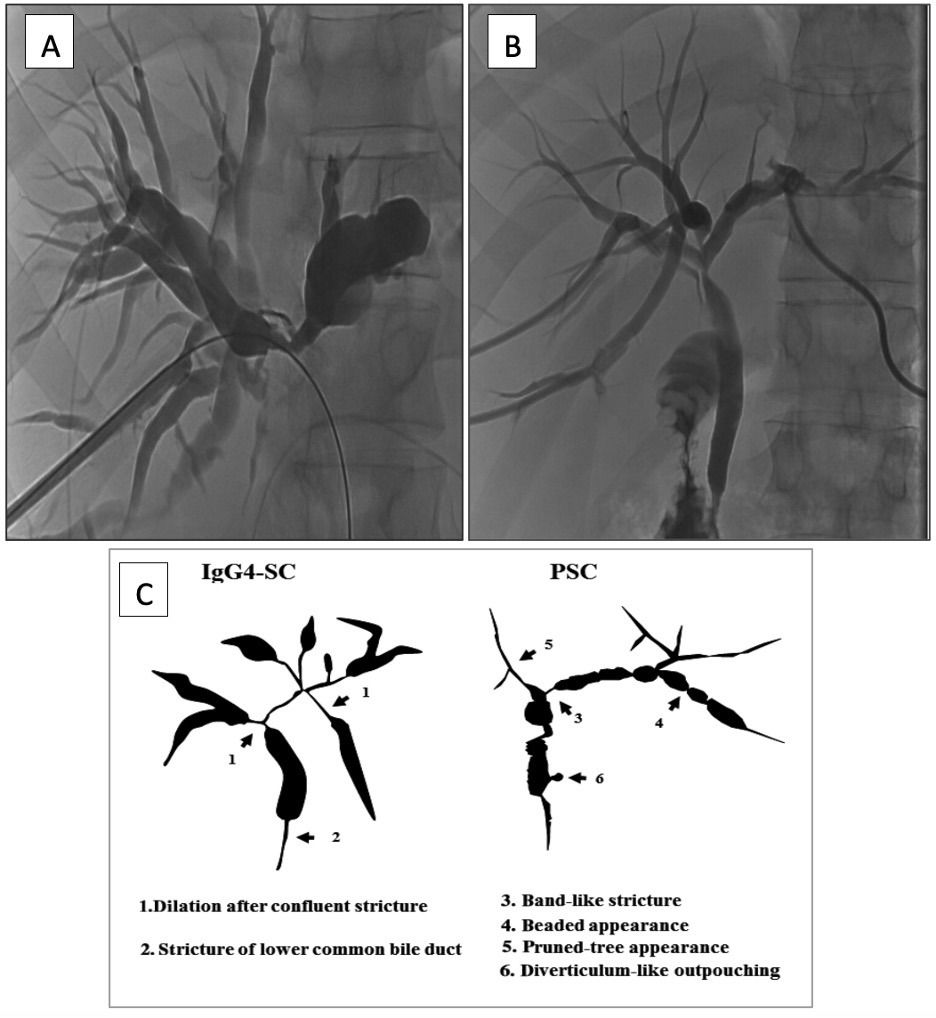Monday Poster Session
Category: Biliary/Pancreas
P1573 - Diagnosing IgG-4 Related Sclerosing Cholangitis
Monday, October 23, 2023
10:30 AM - 4:15 PM PT
Location: Exhibit Hall

Has Audio

Madeline Novack, MD
Tulane University School of Medicine
New Orleans, LA
Presenting Author(s)
Madeline Novack, MD1, John Bloch, MD, MPH1, Behnam Laderian, MD2, Jaya Bommireddipally, MD3, Benjamin A. Guider, MD1
1Tulane University School of Medicine, New Orleans, LA; 2Tulane Medical Center, New Orleans, LA; 3Tulane University, New Orleans, LA
Introduction: IgG4-related sclerosing cholangitis (IgG4-SC) is a rare biliary manifestation of IgG4-related disease. It is characterized by fibrosis of the biliary duct walls, elevated serum IgG4 levels, a frequent association with autoimmune pancreatitis, and an excellent response to steroids. The diagnosis of IgG4-SC requires many diagnostic modalities to rule out diseases such as cholangiocarcinoma (CCA) and primary sclerosing cholangitis (PSC), which are similar to IgG4-SC but have drastically different prognoses and management.
Case Description/Methods: A 33-year-old man with a medical history of gallstones presented due to 6 weeks of jaundice and diffuse pruritis. Laboratory values showed a cholestatic pattern of liver injury. MRCP showed thickening and distension of the gallbladder with intrahepatic ductal dilation, gallstones, and a dilated common bile duct. He underwent cholecystectomy without resolution of his symptoms or improvement in labs. A serum CA 19-9 was elevated to 7453U/mL and a serum IgG4 level was elevated to 160mg/dL. ERCP showed narrowing of the right hepatic and common bile ducts and dilation. A bile duct biopsy was obtained, which showed fibrous tissue with lymphoplasmacytic infiltrate. Immunostaining showed rare IgG4 plasma cells (less than 10 IgG4 positive plasma cells per high-powered field). The patient began a trial of steroids. Repeat cholangiography after one month of steroids showed improvement in ductal dilation. Our patient's symptoms improved and a repeat CA19-9 was 31U/mL.
Discussion: IgG4-SC shares many characteristics with CCA and PSC. In both diseases, patients can have obstructive jaundice and strictures on cholangiography. Visualizing the pathognomonic "beads on a string" strictures of PSC, which contrast with the long dilations of IgG4-SC, can differentiate the two diseases. Ruling out CCA is more difficult. CCA can also present with elevated serum levels of IgG4, IgG4 positive plasma cells on biopsy, and may even temporarily improve with steroid administration. Additionally, as was seen in our patient, CA 19-9 levels can be elevated in IgG4-SC secondary to obstruction. This case study emphasizes that even an extensive workup may not fully exclude CCA and that close follow-up is necessary for patients with suspected IgG4-SC. This should include frequent monitoring of liver enzymes and CA 19-9 levels off of steroids.

Disclosures:
Madeline Novack, MD1, John Bloch, MD, MPH1, Behnam Laderian, MD2, Jaya Bommireddipally, MD3, Benjamin A. Guider, MD1. P1573 - Diagnosing IgG-4 Related Sclerosing Cholangitis, ACG 2023 Annual Scientific Meeting Abstracts. Vancouver, BC, Canada: American College of Gastroenterology.
1Tulane University School of Medicine, New Orleans, LA; 2Tulane Medical Center, New Orleans, LA; 3Tulane University, New Orleans, LA
Introduction: IgG4-related sclerosing cholangitis (IgG4-SC) is a rare biliary manifestation of IgG4-related disease. It is characterized by fibrosis of the biliary duct walls, elevated serum IgG4 levels, a frequent association with autoimmune pancreatitis, and an excellent response to steroids. The diagnosis of IgG4-SC requires many diagnostic modalities to rule out diseases such as cholangiocarcinoma (CCA) and primary sclerosing cholangitis (PSC), which are similar to IgG4-SC but have drastically different prognoses and management.
Case Description/Methods: A 33-year-old man with a medical history of gallstones presented due to 6 weeks of jaundice and diffuse pruritis. Laboratory values showed a cholestatic pattern of liver injury. MRCP showed thickening and distension of the gallbladder with intrahepatic ductal dilation, gallstones, and a dilated common bile duct. He underwent cholecystectomy without resolution of his symptoms or improvement in labs. A serum CA 19-9 was elevated to 7453U/mL and a serum IgG4 level was elevated to 160mg/dL. ERCP showed narrowing of the right hepatic and common bile ducts and dilation. A bile duct biopsy was obtained, which showed fibrous tissue with lymphoplasmacytic infiltrate. Immunostaining showed rare IgG4 plasma cells (less than 10 IgG4 positive plasma cells per high-powered field). The patient began a trial of steroids. Repeat cholangiography after one month of steroids showed improvement in ductal dilation. Our patient's symptoms improved and a repeat CA19-9 was 31U/mL.
Discussion: IgG4-SC shares many characteristics with CCA and PSC. In both diseases, patients can have obstructive jaundice and strictures on cholangiography. Visualizing the pathognomonic "beads on a string" strictures of PSC, which contrast with the long dilations of IgG4-SC, can differentiate the two diseases. Ruling out CCA is more difficult. CCA can also present with elevated serum levels of IgG4, IgG4 positive plasma cells on biopsy, and may even temporarily improve with steroid administration. Additionally, as was seen in our patient, CA 19-9 levels can be elevated in IgG4-SC secondary to obstruction. This case study emphasizes that even an extensive workup may not fully exclude CCA and that close follow-up is necessary for patients with suspected IgG4-SC. This should include frequent monitoring of liver enzymes and CA 19-9 levels off of steroids.

Figure: Images A and B depict cholangiography in our patient. Image A shows dilated bile ducts and segmental narrowing, which is improved after steroid administration, as shown in image B. Image C is an illustration of the differences in cholangiographic findings between IgG4-SC and Primary Biliary Cholangitis.
Disclosures:
Madeline Novack indicated no relevant financial relationships.
John Bloch indicated no relevant financial relationships.
Behnam Laderian indicated no relevant financial relationships.
Jaya Bommireddipally indicated no relevant financial relationships.
Benjamin Guider indicated no relevant financial relationships.
Madeline Novack, MD1, John Bloch, MD, MPH1, Behnam Laderian, MD2, Jaya Bommireddipally, MD3, Benjamin A. Guider, MD1. P1573 - Diagnosing IgG-4 Related Sclerosing Cholangitis, ACG 2023 Annual Scientific Meeting Abstracts. Vancouver, BC, Canada: American College of Gastroenterology.
